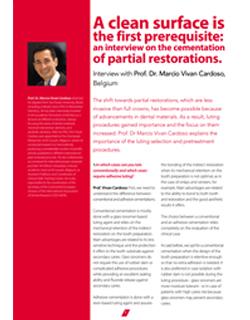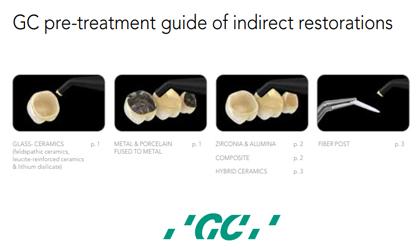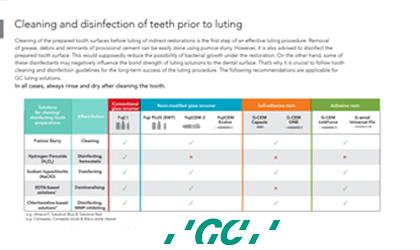Always start with a clean surface!
This is the first rule for achieving effective adhesion.
Clean with pumice or sandblasting: eliminate saliva, blood, plaque, or remnants of temporary cement. Sandblasting also removes the smear layer.

A clean surface is the first prerequisite:
an interview on the cementation of
partial restorations.
Interview with Prof. Dr. M. V. Cardoso, Belgium
How about disinfection?
In case disinfection is desired, chlorhexidine can safely be used. This also inhibits metalloproteinases, which can degrade the bonding interface over time. Alcohol should be avoided because it dehydrates the surface. Hydrogen peroxide should be avoided in combination with any resin since the oxygen inhibits polymerisation.
When using a glass ionomer based cement (e.g. FujiCEM Evolve):
-
Polyacrylic acid (GC Dentin Conditioner) removes the smear layer and enhances the surface energy to make it more receptive for the cement.
-
EDTA can be used if desired; it partially dissolves the smear layer but doesn’t affect the bond strength of glass ionomer based cements.
-
Remember to keep the surface slightly moist after cleaning in order to allow chemical adhesion to take place
When using an adhesive resin cement (e.g. G-CEM ONE):
-
Use your preferred adhesive system.
-
When G-CEM ONE is used, a separate adhesive is not needed if the preparation has sufficient retention and resistance.
-
If increased adhesion is required, such as for partial or very convergent preparations, G-CEM ONE Adhesive Enhancing Primer or G-Premio BOND could be used.
When immediate dentine sealing (IDS) has been applied:
- Sandblast the preparation to clean it and to create micro retention. Enamel margins are etched with phosphoric acid; thereafter, the bonding procedure can be applied as usual.



